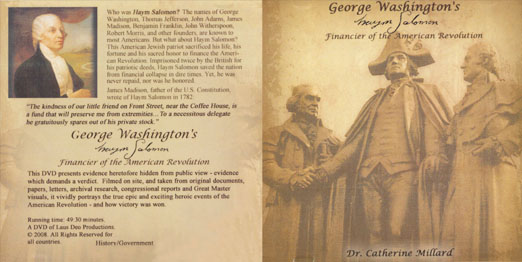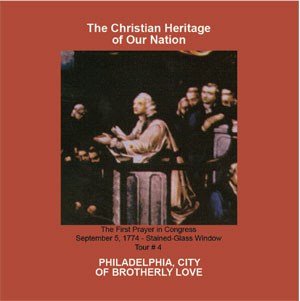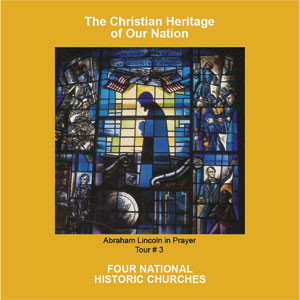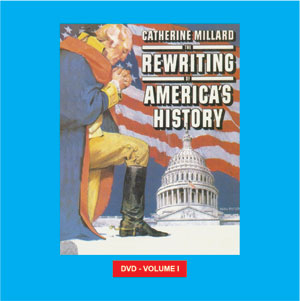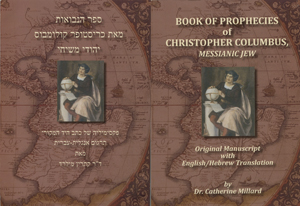A December 20, 1990 syndicated article by investigative journalist, George Archibald, entitled “Without a Prayer – Relics of Religious Heritage Relegated to Federal Closets” appeared in the Washington Times. It was based upon evidence presented by The National Christian Heritage Foundation (now Christian Heritage Ministries) and had a significant impact upon Americans who treasure their original history. My book, The Rewriting of America’s History, documenting hundreds of these tragic incidences, was released in November, 1991. A Washington Post article, dated March 29, 1992, entitled “Library of Congress Rip-Off” however, shifted the culpability for the hundreds of thousands of “missing in inventory” books, onto researchers and scholars. On the same day, the Library of Congress stacks were permanently closed to researchers and scholars.
Since The Rewriting of America’s History was first published, we have evidenced at a cataclysmic rate, further removals, camouflages, and/or subtle rewritings of plaques, brochures, pamphlets, inscriptions and tours in America’s foremost historic sites of national commemoration.
In December, 1999, a hundred and fifty copies of The Rewriting of America’s History were acquired and presented to each member of the Kentucky Congress prior to their convening in January, 2000; resulting in the Kentucky Senate Resolution, which cited the book, taking a stance against having their history rewritten through the ACLU Ten Commandments court case. The book has been instrumental in helping legislators in the on-going struggle to preserve and maintain America’s original Christian heritage and history from being stripped by the ACLU.
In 2000, my eighth book, The Christian Heritage of the 50 United States of America was released. That same year, the ACLU sued the State of Ohio and won, making Ohio’s official State Motto, “With God all Things are Possible” (Matthew 19:26) unconstitutional. The case was appealed to the 6th Circuit Court of Appeals by the State of Ohio. This book, being presented to a defending attorney, was instrumental in helping reverse the decision, the court ruling 9-4 that Ohio’s State Motto was indeed constitutional.
In the Introduction to the book, The Christian Heritage of the 50 United States of America, I have outlined some of the numerous ACLU and American Atheists’ court cases aimed at removing the original Christian heritage and history of the American people, beginning with the official Seal of the city of Zion, Illinois 1986 court case. It is interesting to note that the U.S. Supreme Court declined to hear this case.
The Rewriting of America’s History, Volume I DVD, produced in 1996, includes and updates The United States Supreme Court chapter in my book. Extensive research was done documenting original evidence, showing that The Ten Commandments are etched in marble in the frieze above the Bench, standing out in prominence between “The Majesty of the Law” to the left and “The Power of Government” to the right, by sculptor Adolph A. Weinman.
The 1975 official U.S. Supreme Court Handbook, prepared under the direction of Mark Cannon, Administrative Assistant to Chief Justice, Warren E. Burger, states: “Directly above the Bench are two central figures, depicting Majesty of the Law and Power of Government. Between them is a tableau of the Ten Commandments…” and “To the right of visitors is a procession of historical lawgivers of the pre-Christian era:…” and “To the left are historical lawgivers of the post-Christian era…” (pages 19 & 20).
On May 12, 1987, the United States Supreme Court was designated by Secretary of the Interior, Donald Hodel, as a National Historic Landmark. Consequently, it came under the control of the United States Department of the Interior, National Park Service for jurisdiction over exhibits, curators, tours, tourist information, brochures, pamphlets, etc.
The official U.S. Supreme Court Handbook was subsequently rewritten in 1988, removing the words “The Ten Commandments” between “The Majesty of the Law” and “The Power of Government,” directly above the Bench; as well as “lawgivers of the pre-Christian era” and “lawgivers of the post-Christian era:”
The Docket Sheet (Supreme Court Newsletter) July-September, 1975, highly commends this official Supreme Court Handbook.
At that time, prior to the publication of The Rewriting of America’s History, I was interviewed on national radio and television programs on the subject, expounding upon Adolph A. Weinman’s sculpture depicting The Ten Commandments above the Bench in the inner courtroom of the U.S. Supreme Court. Numerous teachers and educators called the U.S. Supreme Court curators for information of this fact. They related to Christian Heritage Ministries® that they were told by the curators “that they were not The Ten Commandments, but ‘early written laws’ which were unknown to them.” After its designation as a National Historic Landmark in 1987, the U.S. Supreme Court’s North ground floor Exhibit came into being, depicting plaster models of the four Courtroom marble friezes (north, south, east and west) beneath the ceiling. The East Wall frieze’s rewritten caption read:
East Wall plaster model of Courtroom Frieze. The Central focus of the frieze located directly above the Bench is on the seated figures representing ‘Majesty of the Law’ and ‘Power of
Government.’ The tablet between them symbolizes early written laws…
In 1999, U.S. Supreme Court inner courtroom lectures (five per day) began stating that “Between the ‘Majesty of the Law’ and the ‘Power of Government’ was a depiction of the first ten amendments to the Bill of Rights.” We were also informed by U.S. Supreme Court guards at the main entranceway to the inner courtroom, that they had been instructed to inform inquirers that ‘early written laws’ had become the first ten amendments to the Bill of Rights. The typed letter produced by the U.S. Supreme Court curators is without original evidence or documentation, without letterhead and/or typed or signed name of sculptor Adolph A. Weinman.
On May 15, 2003, Herbert Titus, Esq. and his assistant, attorneys to Alabama Chief Justice Roy Moore, called Christian Heritage Ministries, requesting original information on the existence of The Ten Commandments in the frieze above Chief Justice Rehnquist’s head. During our conversation, I expounded upon Adolph Weinman’s sculpture, confirming that The Ten Commandments were displayed above the Bench. I referred him to both the book and the DVD The Rewriting of America’s History, which he acquired. Mr. Titus had been directed by the U.S. Supreme Court curators (as have educators and enquirers nationwide since 1999), to a letter provided by them, purportedly from sculptor Adolph A. Weinman, stating that between “The Majesty of the Law” and “The Power of Government” stood the first ten amendments to the Bill of Rights. However, this letter has neither sculptor Adolph A. Weinman’s letterhead, nor his signature and/or typed name, as all his original letters have, nor does it appear in any of the original files and records I have consulted.
The U.S. Supreme Court Curators’ October 31, 1932 typed, unsigned letter, purportedly from Adolph A. Weinman, sculptor of the four friezes in the U.S. Supreme Court Room, is fictitious, as proven by letters, dated and signed by the sculptor, and stamped officially “RECEIVED:”
1) The sculptor’s June 20, 1932 Contract No.AC.sc-11 with the United States government for furnishing services in connection with the modeling and carving of the sculptured panels for the Supreme Court Room in the building for the United States Supreme Court, Washington, D.C., called for all official correspondence between the sculptor, Adolph A. Weinman, 234, Greenway South, Forest Hills, Long Island, N.Y., and the firm of architects, Messrs. Cass Gilbert, Cass Gilbert, Jr. and John R. Rockart, 244, Madison Avenue, New York City, to have a copy sent to Mr. David Lynn, Architect of the Capitol, Washington, D.C., who oversaw this Contract; and vice versa.
2) Such correspondence called for the official received stamp of the architect, “CASS GILBERT, RECEIVED (and date)” as borne out by official letters, signed by the sculptor, A.A. Weinman.
3) The sculptor, Adolph A. Weinman’s, October 10, 1932; April 15, 1933; and April 17, 1933 official, stamped “RECEIVED” letters show clearly that both the sculptor’s sketch models (3/4”) and his subsequent scale models (2 ¼”) were ready for the Architect’s inspection, at the site of Weinman’s place of business, on Long Island; which refutes the unsigned, fictitious October 31, 1932 letter’s statement that the sculptor’s plaster casts of his sketch models were physically sent to the Architect’s firm.
4) The official Contract ACsc-11 Requisition No. 8, Schedule of Payment addressed to sculptor Adolph A. Weinman, amounting to $120,000.00, with amounts due under terms of Article 10 of said Contract, is APPROVED by the ARCHITECT OF THE CAPITOL, overseer of this U.S. government Contract, and signed by the Architectural firm of Cass Gilbert, Cass Gilbert Jr., and John R. Rockart, as well as by the sculptor, Adolph A. Weinman.
5) With an official U.S. Government Contract of this magnitude, importance and cost, an unsigned, October 31, 1932 letter, lacking the sculptor’s signature, name and official “CASS GILBERT, RECEIVED (and date) stamp” and/or letterhead of the sculptor, is clearly proven to be fictitious.
A typed letter, with neither the sculptor’s letterhead, nor his signed/typed name, nor his customary formal address to the recipient, as proof given by the U.S. Supreme Court curators that Adolph A. Weinman’s sculpture above the U.S. Supreme Court Chief Justice’s head, featuring The Ten Commandments’ traditional Roman numerals I-V to the left and VI-X to the right, is actually the first ten amendments to the Bill of Rights, appears to be inadequate evidence in a court of law.
In Adolph Alexander Weinman’s U.S. Supreme Court Building Description of Sculpture Courtroom, no mention is made there, nor in any other original by A. A. Weinman, of the first ten amendments to the Bill of Rights in the East Wall Frieze above the Bench.
Also of note is page 27 from a Library of Congress book depicting church symbolism, showing the Ten Commandments traditionally depicted by Roman numerals, I-V to the left and VI-X to the right. These match the depiction of the Ten Commandments etched on the lower part of each of the oak doors of the main entranceway leading into the inner courtroom of the U.S. Supreme Court – their only symbolism. When the doors are closed, The Ten Commandments face the Bench.
It is interesting to note that Chief Justice William H. Rehnquist is quoted in a 1997 Washington Post article as stating “it is unlawful to remove or in any way injure an architectural feature in the Supreme Court building.”
The Ten Commandments
in Adolph A. Weinman’s sculpture –
The Oscar S. Straus Memorial in Washington, D.C.
Also of note is the bronze masterpiece sculpture by Adolph A. Weinman in Washington, D.C. entitled, The Oscar S. Straus Memorial:
“The grouping represents Justice, portraying Religious Freedom. A reclining, draped damsel leans upon a tablet containing the Ten Commandments in Roman numerals. Her hands are clasped in prayer.”
In his original, signed letter dated July 25, 1940 to David Hinshaw, Adolph A. Weinman states that this is the Ten Commandments. David Hinshaw was Secretary of The Oscar S. Straus Memorial Association. This letter was validated by David Hinshaw’s reply dated July 31, 1940 and by Roger W. Straus’ July 29, 1940 response.
An October 27, 1947 Washington Post article entitled “Truman Pays Tribute to Oscar Straus” states that the Memorial was authorized by a joint resolution of Congress in 1929 after an informal nationwide poll had named Straus as the Jew who, because of his service to the nation, most deserved to be honored with a statue in the Capital. President Truman, praising Straus, stated that while he was ambassador to Turkey during the administrations of Cleveland, McKinley, and Taft, “ he did more for the Christians in Turkey than all the ambassadors we had had there up to that time put together.” With a smile the President noted Sunday school in his youth and said “of course that appealed to me, also.”
This tablet of the The Oscar S. Straus Memorial is identical to Weinman’s sculpture of the Ten Commandments directly above the Chief Justice’s head in the U.S. Supreme Court courtroom.
An inscription upon the base of The Oscar S. Straus Memorial reads: “ Our Liberty of Worship Is not a Concession Nor a Privilege But an Inherent Right.”
Oscar S. Straus wrote a brilliant Address entitled The Origin of Republican Form of Government in the United States and the Hebrew Commonwealth. A New York Times article dated January 11, 1884 entitled The Hebrew Commonwealth, reiterates his words as follows:
“ The fact was shown that in the history of nations modern systems are formed by reverting to first principles. In the conception of the American Union, Mr. Straus showed how deeply Americans were imbued with religious principles. The Bible was studied as no people excepting only the Jews had studied it. The Pilgrims likened themselves to the children of Israel; they quoted text and chapter, and adapted these themselves. They had suffered as the Jews, Egyptian bondage; they had passed through the Red Sea. The King of England was Pharaoh. Even in after days, Washington and Adams were styled their Moses and Joshua. In accordance with these Scriptural ideas, was it at all surprising that their first conception of the American Union should be derived from a theocracy – the same form of government in all its essential characteristics as the children of Israel set up for the twelve tribes under their great lawyer, Moses? ”
To learn more, click here.

